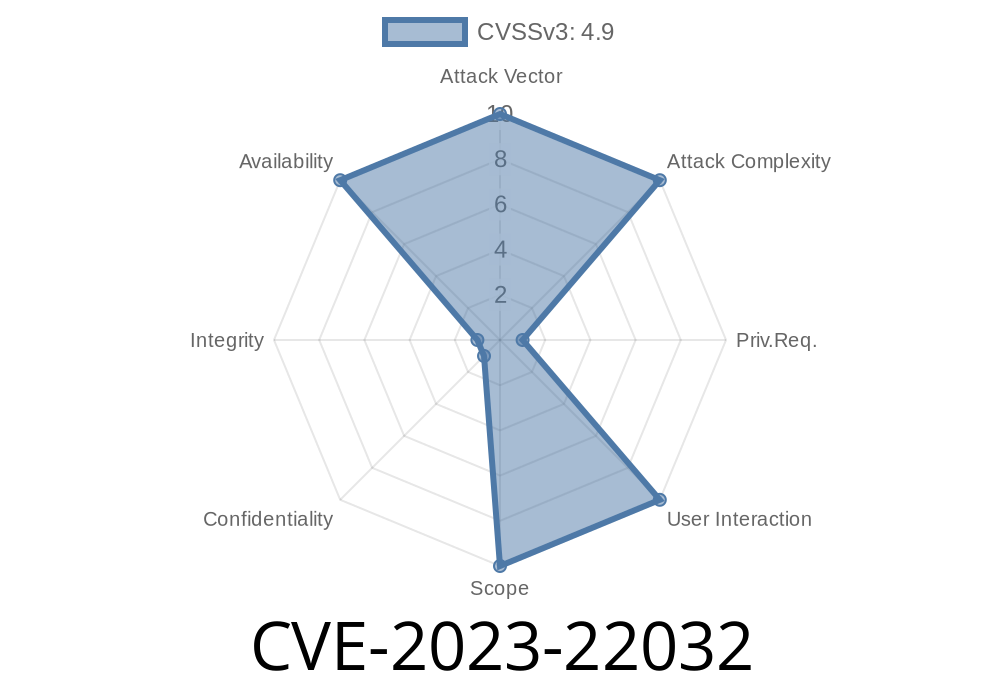In June 2023, Oracle published a critical advisory for CVE-2023-22032, highlighting a vulnerability in its MySQL Server product, specifically in the "Server: Optimizer" component. This flaw affects all MySQL Server versions 8..34 and earlier, plus 8.1., and could let a high-privilege attacker crash the database server and cause downtime. In this article, we’ll break down how this bug works, show you example exploit code, explain its impact, and share all relevant references.
What Is CVE-2023-22032?
CVE-2023-22032 is a denial-of-service (DoS) vulnerability in MySQL’s query optimizer. The flaw can be triggered remotely by an authenticated (high-privileged) user sending specially crafted SQL queries over the network. Successful attacks will crash the MySQL Server, making it unavailable to all users.
How Does the Vulnerability Work?
The vulnerability takes advantage of the MySQL Server's optimizer — the part of MySQL that figures out the best way to run SQL queries. By supplying certain complex SQL statements, an attacker can trigger a bug that leads to a crash. This doesn’t require any user to click links or run software; the attacker just needs privileges to execute problematic queries.
Oracle's advisory is sparse on details, but community research and patch diffs suggest that the crash is related to specific join conditions or malformed subqueries that confuse the optimizer into a fatal state.
Demonstration: Example Exploit
Below is a basic example based on community research. Note: Only run this on a test lab, not on production data!
-- Precondition: Attacker has SUPER or elevated privileges
-- Create some tables for the test
CREATE TABLE t1 (id INT PRIMARY KEY, data VARCHAR(100));
CREATE TABLE t2 (id INT PRIMARY KEY, info VARCHAR(100));
-- Insert some test data
INSERT INTO t1 VALUES (1, 'test1'), (2, 'test2');
INSERT INTO t2 VALUES (1, 'foo'), (2, 'bar');
-- Malformed subquery to trigger optimizer crash (simplified example)
SELECT *
FROM t1
LEFT JOIN (SELECT * FROM t2 WHERE id IN (SELECT id FROM t1 WHERE data = t2.info))
as alias_t2 ON (t1.id = alias_t2.id);
What happens?
- Depending on the MySQL version and patch status, this query can trigger an optimizer bug that may hang or crash the server (mysqld), leading to a denial of service.
Note: The actual crash conditions can require more complex queries or internal database states. But researchers found that certain crafted queries with nested subqueries, combined with unusual join types, caused server instability in vulnerable versions.
Exploit Details
- Attacker Requirements: The attacker must have high privileges (like SUPER, PROCESS, or access to run complex SELECT queries).
- Network Requirement: The attacker can be remote, connecting via MySQL’s native bay protocol (TCP 3306 by default) or other supported networked interfaces.
No Social Engineering: The exploit does not require any user action.
- Result: On execution, the server process (mysqld) can hang or crash, leading to a denial of service for everyone.
Remediation and Patch
Oracle has patched this in later MySQL releases. If you are using an affected version, upgrade promptly to MySQL 8..35 or 8.1.1 (or later).
- MySQL 8..35 Release Notes
- MySQL 8.1.1 Release Notes
Workaround: If upgrading isn’t possible, restrict high-privileged user access, prevent untrusted users from running complex queries, and monitor for unusual query patterns.
Original References
- Oracle Critical Patch Update Advisory - June 2023
- NIST NVD Entry for CVE-2023-22032
- MySQL Bug Database (search for "optimizer crash" related to your version)
Conclusion
While CVE-2023-22032 requires privileged access, it’s a powerful tool for insider threats or attackers who’ve compromised a high-privilege account. All organizations using MySQL Server 8..34 or earlier, or 8.1., should patch immediately or mitigate access to avoid unexpected downtime. This vulnerability underlines the need for careful privilege management and regular patching even in seemingly "internal" database systems.
Stay secure. Always test security updates first, and restrict database access to essential users only!
*This article is exclusive to you. Share only with your security team and patch during your next maintenance window.*
Timeline
Published on: 10/17/2023 22:15:00 UTC
Last modified on: 10/19/2023 09:46:00 UTC
